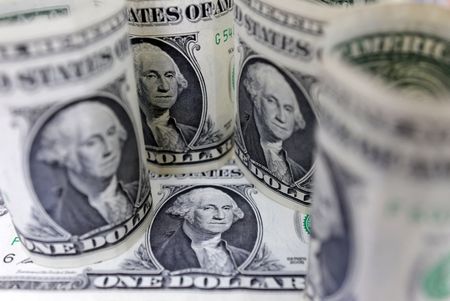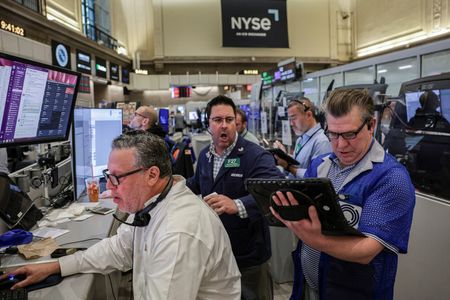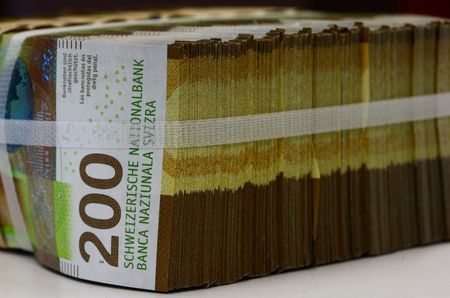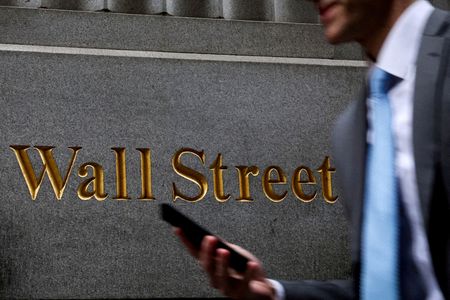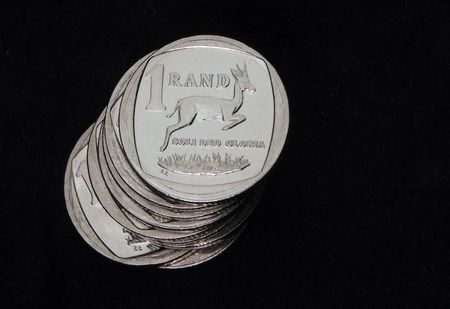By Chuck Mikolajczak
NEW YORK (Reuters) -The U.S. dollar rose on Wednesday to move further from recent 11-week lows, as investors assess the strength of the economy and tariffs outlook after the most recent comments from U.S. President Donald Trump.
The greenback stumbled on Tuesday as economic data showed a sharp drop in consumer confidence, the latest in a string of data points that have prompted concerns about the strength of the U.S. economy and persistent inflation, and caused U.S. Treasury yields to tumble.
The benchmark 10-year U.S. Treasury yield plunged nearly 10 basis points (bps) on Tuesday and was last down 4.2 basis points to 4.256% after falling to 4.249%, its lowest since December 11 as an earlier attempt to stabilize dissipated.
“We’ve had a pretty good sell-off since January, a lot of that’s been fueled by the adjustment lower in U.S. real rates, which was largely fueled by the underperforming data we’ve been seeing, including yesterday,” said Brad Bechtel, global head of FX at Jefferies in New York.
“We’re at a stage now where we’re probably just going to chop around for a bit until we hear more about what’s actually happening with tariffs.”
The dollar index, which measures the greenback against a basket of currencies, rose 0.21% to 106.46, with the euro down 0.26% at $1.0486.
The greenback had fallen nearly 4% from a more than two-year high hit in January as worries have emerged about U.S. economic growth as well as inflation, as investors deal with shifting tariff deadlines by Trump on Canada and Mexico. Investors are also bracing for the labor market impact from actions taken by Elon Musk’s Department of Government Efficiency.
The Canadian dollar weakened 0.9% versus the greenback to C$1.43 while the Mexican peso strengthened 0.3% versus the dollar at 20.406.
Trading in both currencies was choppy after Trump said at a cabinet meeting that they would take effect on April 2, but a White House official, however, said the March 4 deadline for the tariffs on Mexican and Canadian goods remained in effect “as of this moment.”
Even with the recent declines, the dollar has risen in three of the past four sessions and “the market is still respecting the fact that there’s an underlying bid tone to the dollar overall, and that’s kind of why we’re holding in around 106 for now,” said Bechtel.
Markets are currently pricing in 57 bps of rate cuts from the U.S. Federal Reserve by the end of the year, with expectations for a cut of at least 25 bps not topping 50% until the June meeting.
Richmond Federal Reserve President Tom Barkin said on Tuesday he will follow a wait-and-see approach regarding central bank interest rate policy until it is clear inflation is returning to the Fed’s 2% target given the current uncertainty surrounding the economy.
The U.S. Commerce Department said on Wednesday that new home sales plunged 10.5% to a seasonally adjusted annual rate of 657,000 units last month, short of the 680,000 estimate of economists polled by Reuters, hurt by persistently high mortgage rates and unusually cold weather in some parts of the country.
Investors were also eyeing any peace talks over Ukraine, which could affect the euro area economy and the single currency.
Ukraine said on Wednesday it had reached a “preliminary” deal to hand revenue from some of its mineral resources to the United States, before an expected trip to Washington by President Volodymyr Zelenskiy on Friday.
Against the Japanese yen, the dollar weakened 0.04% to 148.96 after falling to 148.56 on Tuesday, its lowest since October 11.
Sterling strengthened 0.09% to $1.2677. Bank of England policymaker Swati Dhingra said the BoE’s response to higher tariffs and other trade restrictions will depend on the extent supply chains are disrupted and not just increasing costs, as higher tariffs would likely be offset by softer global growth in the short-term.
(Reporting by Chuck Mikolajczak; Editing by Nick Zieminski and Daniel Wallis)

